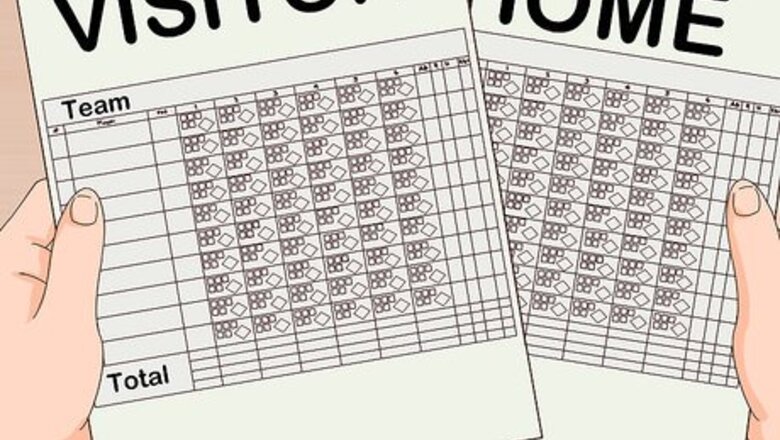
views
Setting up Your Scorecard
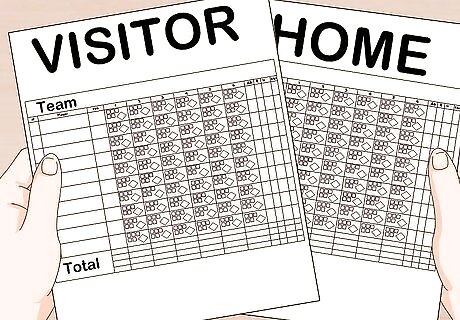
Use pre-printed softball scoring cards to score your game. You can either purchase a notebook with scorecards from sports stores, or you can print off scoring sheets from the internet at home. Assign 1 scorecard per team, one for the home team and another for the visiting team. You can find scoring cards online by searching "printable scoring cards" on Google.
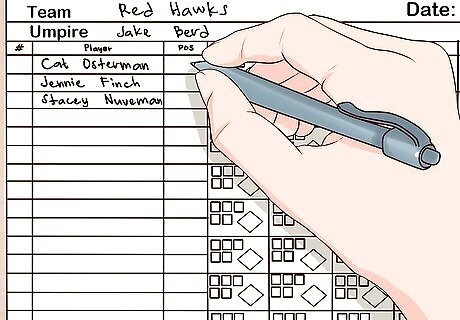
Write out the players' names in batting order. You can write one name per row, starting with the 1st batter. Fill this out for the "Batter" and "Pitcher" columns. Include other relevant information on your scorecard, like team, umpire, and the date. You can make a separate section at the bottom for bench players, if you’d like.
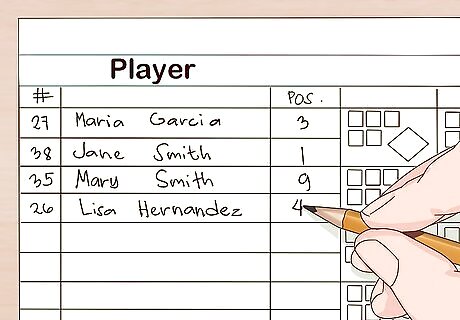
Write down each players' jersey number and abbreviated position. Typically the jersey number is listed first, followed by the players' name, and then the players' position number. In softball, each position is assigned a number in order to keep track with your scorecard. There are other positions that receive alphabetical abbreviations, as well. 1 = Pitcher, 2 = Catcher, 3 = 1st base, 4 = 2nd base, 5 = 3rd base, 6 = Shortstop, 7 = Left field, 8 = Center field, and 9 = Right field. There are also 2 other player positions to abbreviate. Designated Hitter (DH) is the player who only hits for someone who only plays on the field. Pinch hitter (PR) is a player who is substituted to bat for a player in the starting lineup. If the pitcher is hitting, you can include them in your lineup. If not, DH will take your pitcher’s spot.
Marking Players’ Progress
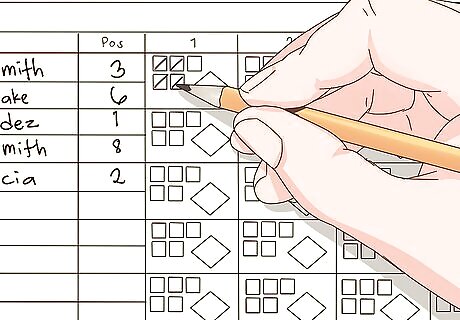
Mark the balls and strikes for each batter in the designated grids. When someone is up to bat, take note of what they hit for each pitch on your scorecard. Record the number of balls hit in the row with 3 squares and the number of strikes in the row with 2 squares. Make your marks with Xs, checks, or slashes--whatever feels right to you. After each pitch, the umpire will shout out the call and hold up his hands to indicate the count so far, such as 2 balls and 2 strikes. When giving the count, balls will always come before strikes.
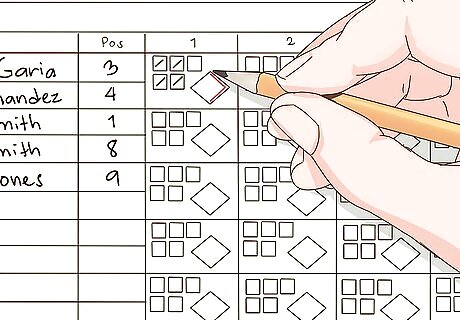
Draw a line to the correct base after a player makes a run. You will see a small diamond shape to the right of your players' names. When a player reaches a base, draw a line connecting to that base. You will go around the diamond just like the players are doing. You may be completing this for multiple players at the same time, depending on whose on what base. For example, if someone makes it to 1st base, draw a line connecting the home position to the 1st base position. If someone gets a home run, then fill in the entire diamond.

Include abbreviations to give more details for each play. In addition to drawing the lines around the bases, add abbreviations to give details about the player’s turn. A player can hit a single, double, triple, or home run. They can also earn a walk if the pitcher throws poorly.
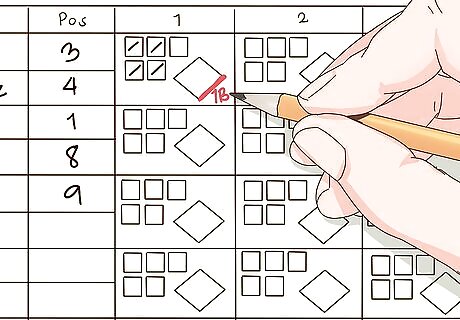
Write “1B” if a batter gets a single. A single is the most basic hit, where the batter runs to 1st base safely. Draw a line from the home to 1st base on your diamond, and write “1B” next to it.
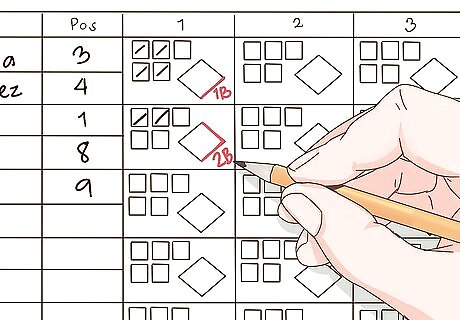
Record “2B” if a batter gets a double. A double is when a batter makes it to 2 bases in one turn without any errors. Draw a line from home, to 1st, and to 2nd. Write “2B” next to the line.
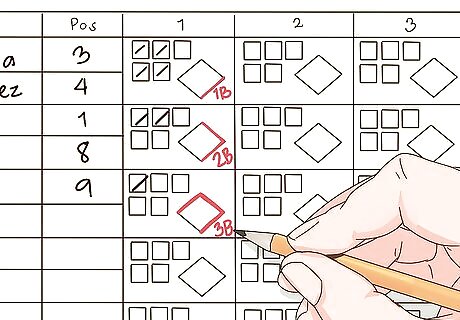
Jot down “3B” if a batter gets a triple. A triple is when a player makes it from home to 3rd base successfully. Draw a line from home base to 1st, 2nd, and 3rd. Then, write “3B” for 3rd base.
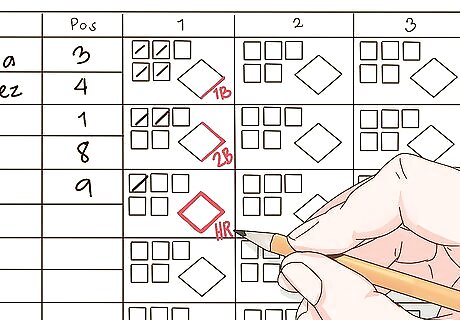
Write “HR” and shade the entire diamond if a batter scores a home run. A home run is when a player successfully hits the ball far enough to run from home base to 1st, 2nd, 3rd, and back to home plate. Outline the entire diamond, shade it in, and write “HR” to indicate a home run.
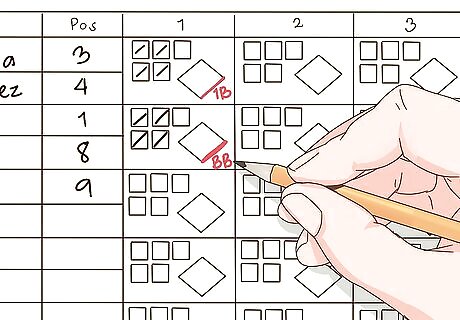
Record “BB” for “Base on Balls” if a batter gets a walk. A walk occurs if the pitcher throws 4 balls and the batter cannot hit any of them. The batter can “walk” to 1st base since they were not pitched a decent throw. Make a line from home to 1st base, and write “BB” for “Base on Balls.”
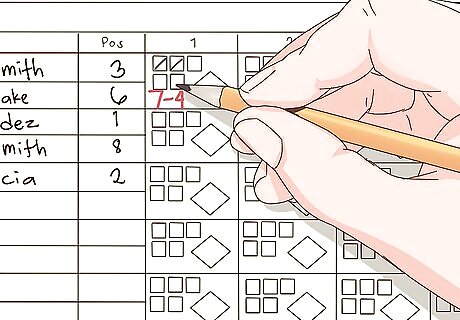
Record which players got out by the other players’ position numbers. Write down the position number for everyone who touched the ball whenever an out is made, using the 1-9 positions abbreviations. 1 = Pitcher, 2 = Catcher, 3 = 1st base, 4 = 2nd base, 5 = 3rd base, 6 = Shortstop, 7 = Left field, 8 = Center field, and 9 = Right field. If a pitch is hit to left field and then a player throws the ball to 2nd base to force the player out, it would read “7-4,” for 7 represents left field, and 4 represents 2nd base.
Abbreviating Outs
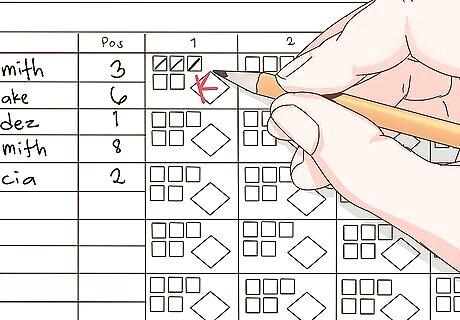
Write “K” in the batter’s box if a player strikes out. A batter strikes out by swinging the bat 3 times without getting a hit. Their turn is now over, and they do not get a position on base.
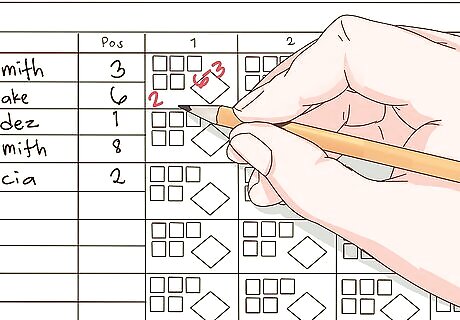
Mark if a player "Grounds Out" by writing the player's position numbers. A “Ground Out” is when the ball is hit to the ground, and a player on the opposing team throws the ball to get a player out. Abbreviate this by listing the position numbers of the opposing players. Write the total number of outs in the inning in the lower left corner, and circle this number. For example, if a ball is hit to shortstop and they throw the ball to the player on 1st base to get the batter out, write “6-3” for the position numbers. Also write “2” in the lower left corner, since this is the 2nd out of the inning.
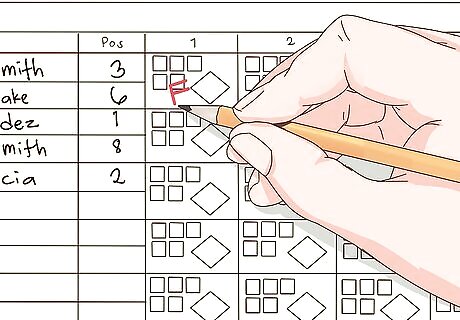
Write a letter “F” and other players' position number to mark a “Fly Out.” A “Fly Out” refers to a ball caught in the air before it hits the ground. In this case, the batter is automatically out. Record this by writing the position number of player who caught the ball. You can still circle the number of players out in the lower left corner. If the player in the right field position caught the ball, write “F10” and then “2” in the bottom.
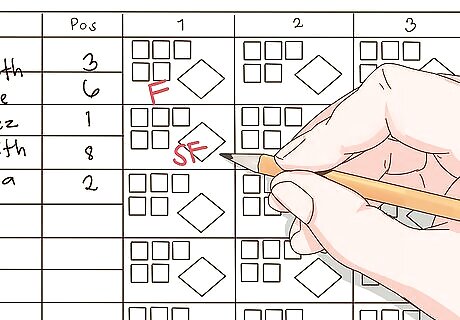
Indicate a “Sacrifice Fly” by writing “SF” and players' position number. A “Sacrifice Fly” occurs when a fly ball is caught and the players already on base run to another base. If a runner makes a score after the fly ball is caught, write down “SF” next to the batter’s name. Include the position number of the person who caught the ball. For example, if the batter hit a ball caught by the left fielder, and afterwards another runner scored, you would mark this batter as “SF7.” You can still circle the number of players out in the lower left corner.
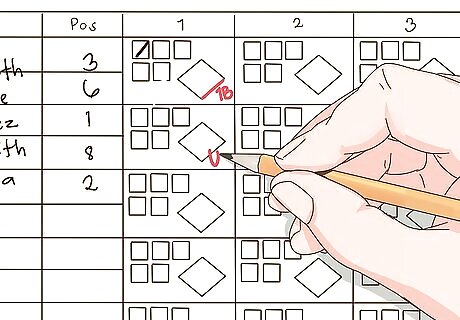
Record "Unassisted Outs" by writing “U” and players' position number. “Unassisted Outs” are when the batter hits the ball to someone on the ground, and the batter gets out without other players throwing the ball. You can score this by writing the position number of the opposing player and then “U.” Let’s say the batter hit the ball to the 2nd baseman, and the 2nd baseman tagged the batter. You can mark this as “4U.”
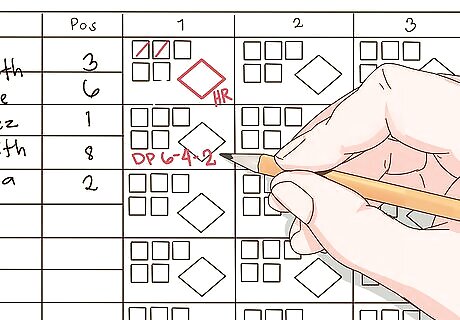
Mark "Double Plays" by recording “DP” and players' position numbers. “Double Plays” occur if 2 players get out in the same play. This can only happen if there are 0 or 1 outs total in the inning. The inning will end when the 3rd out is made. Write “DP” and the position of everyone involved in the play. For example, the batter hits the ball to shortstop. The player on shortstop then throws the ball to 2nd base to get a runner out, as they run from 1st to 2nd base. Then, the 2nd baseman throws the ball to 1st base, to get the batter out. This would be record as “DP 6-4-2.”
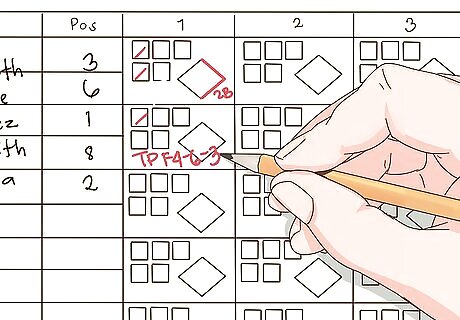
Score a "Triple Play" by writing “TP” and the players’ position numbers. A “Triple Play” is essentially the same as a "Double Play", but with 3 outs instead of 2. If 3 people get out in 1 play, write “TP” and then the position numbers of each player involved. For example, the 1st out could happen if the batter hits the ball to the 2nd baseman, and the 2nd baseman catches the ball in the air. The runners on 1st and 2nd base started running after the batter hit the ball into the air. To get the runner on 2nd base out, the shortstop catches the ball from the 2nd baseman--making the 2nd out. Then, the shortstop throws the ball to the 1st baseman to get out the runner who should’ve remained on 1st base. You would write this as “TP F4-6-3.” Write a 3 in the lower left corner and circle it, since this was the 3rd out.



















Comments
0 comment